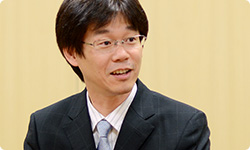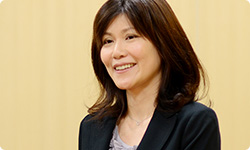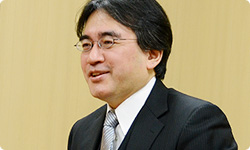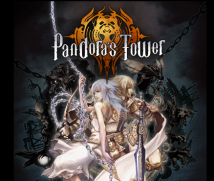3. Inspired By a Lunchbox
The second Jump title 10 was a step up from the first, so it must have been even tougher going. 10 Jump Ultimate Stars was a fighting game released exclusively in Japan in November 2006 for Nintendo DS. It was the sequel to Jump Super Stars.
Yes, it was 1.5 times the size, and we had to do it in two thirds of the time.
And then when you finished that, you moved onto the game we’re going to be discussing today. Could you start by explaining what kind of game Pandora’s Tower is?
To put it simply, the hero’s beloved Elena is cursed and is steadily turning into a beast. In order to escape this curse, the hero has to venture into a number of perilous towers and face an assortment of foes. He must then return to Elena at regular intervals with ‘master flesh’, which helps to stem the progress of the curse. But Elena hates this ‘master flesh’, so you try to minimise the number of times you bring it to her. Leave it too long, however, and her transformation will get more and more severe, and make her more hideous. So while you are enjoying the game, you also have to weigh up when to tackle the towers, and when to head back to Elena.

During development, we’d often liken it to a spouse staying at home while the partner goes out to work. If they come home late, the spouse is going to get angry, so they’ll do their his best to come home early. But at the same time, if they put in longer hours at the office, they’ll earn more money, so there is this dilemma... That’s the nature of the game. This is something Yamakura-san talked about from the very start. (laughs)
I just thought it would make things a bit easier to understand, that’s all. (laughs)
There were actually people here at Nintendo saying the same thing.
This scenario really defines the gameplay to a great degree, as the player is free to decide when they want to return home. You’re able to define the rules yourself, in terms of how long you want to give yourself in the towers before you head back to the heroine. You decide how far you can afford to push ahead. The set-up itself becomes an enjoyable element of the game. It’s not something you can approach systematically, saying: ‘Oh, the timer’s running down, I’d better rush back!’ Everything is very delicately balanced, and I think this is something that’s quite unique about this game.
How did this project initially come about? What was the process that led Ganbarion to developing a game that wasn’t based on an existing IP? This was a new challenge for Ganbarion.
Just after development ended on the last Jump title, I asked Yamakura-san simply: ‘Do you have any desire to work on an original title?’ Straight away, she responded: ‘Yes, I do.’ Then she said that they had an idea they’d been working on, and that she’d like to present it to me.
So you were thinking at some point that you’d like to make an original game?
Yes, we were. Our company had made games based on existing franchises, so I wanted to take up that gauntlet of producing something original. I’d always wanted to make a game that would appeal to boys, from students starting secondary school to around twenty years old. So that’s why I chose to put a woman at the centre of this game. I wanted to explore something that changed, something that underwent a transformation, and I decided that it could be this woman who undergoes that transformation.

I see.
To be more specific, I wanted to express something that had been made impure and then became pure again. I settled on the idea of a woman who was pure being somehow spoiled or corrupted and then becoming pure once more. That was the first element of the story I came up with. I then spent a month racking my brains to come up with the method by which her purity would be restored. It just so happened that I was on a bullet train with Hoga, when he remarked: ‘You know, ekiben lunchboxes (packed lunches sold exclusively at train stations) are really back in fashion at the moment...’ (clapping her hands) It just struck me then and there: ‘Let’s make it so there’s something she’s forced to eat!’ (laughs)
Ah... So the idea came from a remark about lunchboxes? (laughs)
That’s right. The act of eating is such a part of people’s everyday lives that I was sure it would resonate with players. I then thought about what to give her to eat, and it occurred to me that having something really disgusting would serve to underline the heroine’s beauty.
So you’d have that contrast.
Right. That’s why I decided to make it something rather grotesque.
In the game, there’s a law forbidding the eating of meat, isn’t there? What was the thinking behind this?
Around that time, you’d sometimes hear such terms as ‘carnivorous’ girls and ‘herbivorous’ boys’. That was one factor. But I had this impression that, in real life, if a girl literally devours food in front of a boy, he might not find that very attractive. I wanted the image that a girl would eat the food rather reluctantly, so I had the idea of setting the game in a world where eating meat was forbidden. Editor’s note: ‘carnivorous’ and ‘herbivorous’ are the direct English translations of two Japanese fad words spread by the Japanese popular press around the time of this interview, referring to some girls who actively approach boys and the boys who are passively approached by the girls, respectively.
I see. So your ideas are all born out of functionality. That’s very interesting. It’s an extremely effective approach to game design.

I think so. You know the way that, when Mario eats a mushroom, he gets bigger. It looks like the mushroom and Mario have just overlapped and he’s grown bigger, but the player has the sense that Mario has actually eaten it. That instinctive grasp of what’s happened isn’t something you need to explain, which is why I thought that players would get what we were aiming for with that act of eating. As for the action element of the game, too, for example, we adopted actions using a chain because I was rather confident that a girl’s skin and a chain will make a beautiful contrast in the players’ eyes. By repeating this kind of process, we were building up the set-up for the game.
